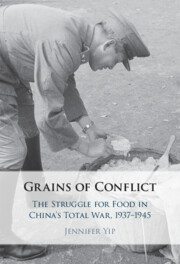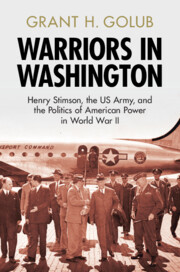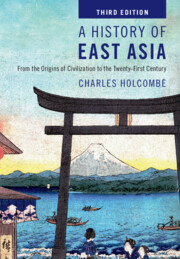Refine search
Actions for selected content:
233 results
20 - The Politics of War Memory in the USSR and Post-Soviet Russia
- from Part VII - Post-war Legacies and Myth-Making
-
-
- Book:
- The Cambridge Companion to the Nazi-Soviet War
- Print publication:
- 20 November 2025, pp 365-381
-
- Chapter
- Export citation
19 - Germany’s Selective Memory of the Eastern Front
- from Part VII - Post-war Legacies and Myth-Making
-
-
- Book:
- The Cambridge Companion to the Nazi-Soviet War
- Print publication:
- 20 November 2025, pp 349-364
-
- Chapter
- Export citation
1 - War Aims: Ralph Bunche, H. G. Wells, and “World Social Democracy”
- from Part I - Internationalizing Human Rights
-
- Book:
- In Defense of Economic and Social Human Rights
- Published online:
- 06 November 2025
- Print publication:
- 20 November 2025, pp 33-66
-
- Chapter
- Export citation

Grains of Conflict
- The Struggle for Food in China's Total War, 1937–1945
-
- Published online:
- 23 August 2025
- Print publication:
- 31 July 2025
Chapter 5 - Reading between the Lines
-
-
- Book:
- Antifascism(s) in Latin America and the Caribbean
- Published online:
- 21 July 2025
- Print publication:
- 07 August 2025, pp 107-125
-
- Chapter
- Export citation
Chapter 6 - Applying the Atlantic Charter to the Caribbean Basin
-
-
- Book:
- Antifascism(s) in Latin America and the Caribbean
- Published online:
- 21 July 2025
- Print publication:
- 07 August 2025, pp 126-142
-
- Chapter
- Export citation
Introduction
-
- Book:
- Grains of Conflict
- Published online:
- 23 August 2025
- Print publication:
- 31 July 2025, pp 1-21
-
- Chapter
- Export citation
Saving Katoku: A Case Study of the Conflicting Environmental and Economic Demands on Japan’s Island Communities
-
- Journal:
- Asia-Pacific Journal / Volume 23 / 2025
- Published online by Cambridge University Press:
- 25 July 2025, e11
-
- Article
-
- You have access
- Open access
- HTML
- Export citation
Introduction: An Experiment in Race Relations
-
- Book:
- A Black Army
- Published online:
- 16 June 2025
- Print publication:
- 17 July 2025, pp 1-14
-
- Chapter
- Export citation

Warriors in Washington
- Henry Stimson, the US Army, and the Politics of American Power in World War II
-
- Published online:
- 23 June 2025
- Print publication:
- 10 July 2025
13 - Carolyn Parker’s Electronic Frequencies
-
-
- Book:
- Women in the History of Quantum Physics
- Published online:
- 02 July 2025
- Print publication:
- 19 June 2025, pp 361-383
-
- Chapter
- Export citation

A Black Army
- Segregation and the US Military at Fort Huachuca, Arizona, 1941–1945
-
- Published online:
- 16 June 2025
- Print publication:
- 17 July 2025

A History of East Asia
- From the Origins of Civilization to the Twenty-First Century
-
- Published online:
- 15 May 2025
- Print publication:
- 05 June 2025
-
- Textbook
- Export citation

Making Do
- Britons and the Refashioning of the Postwar World
-
- Published online:
- 24 April 2025
- Print publication:
- 24 April 2025
5 - Reimagining Youth during Wartime
-
- Book:
- The Age of Youth
- Published online:
- 27 May 2025
- Print publication:
- 24 April 2025, pp 161-189
-
- Chapter
- Export citation
Introduction
-
- Book:
- The Age of Youth
- Published online:
- 27 May 2025
- Print publication:
- 24 April 2025, pp 1-25
-
- Chapter
- Export citation
Introduction
-
- Book:
- Making Do
- Published online:
- 24 April 2025
- Print publication:
- 24 April 2025, pp 1-18
-
- Chapter
- Export citation
Epilogue
-
- Book:
- Making Do
- Published online:
- 24 April 2025
- Print publication:
- 24 April 2025, pp 292-293
-
- Chapter
- Export citation
Conclusion
-
- Book:
- Making Do
- Published online:
- 24 April 2025
- Print publication:
- 24 April 2025, pp 279-291
-
- Chapter
- Export citation
4 - Conscripting Youth for World War II
-
- Book:
- The Age of Youth
- Published online:
- 27 May 2025
- Print publication:
- 24 April 2025, pp 129-160
-
- Chapter
- Export citation
